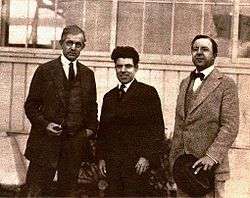Eugene Manlove Rhodes

Eugene Manlove Rhodes (January 19, 1869 – June 27, 1934) was a writer who was nicknamed the "cowboy chronicler".
Biography
Rhodes was born in Tecumseh, Nebraska. He moved to New Mexico with his parents in 1881 and "fell in love" with the state. By age sixteen, he was an accomplished horseman and stonemason and road builder. He helped build the road from Engle, New Mexico, to Tularosa, New Mexico.
Rhodes was an avid reader, and he was mostly self-educated in his youth. In 1888, he studied at the University of Pacific in California. He began publishing anonymous works in the college newspaper. In 1890, he was unable to continue his studies due to financial problems.
His first non-anonymous work was the poem "Charlie Graham".
In 1899, Rhodes married May Louise Davison Purple (1871-1957), a widow with 2 sons. He spent the next two decades away from New Mexico at her home in Apalachin, New York. He published seven novels during this time. He and his wife returned to New Mexico in 1926. They spent less than a year living in Santa Fe. After that they lived in Alamogordo. When they could no longer afford rent there, Albert Bacon Fall gave them a house at White Mountain near Three Rivers, New Mexico. His wife is buried in the Riverside Cemetery at Apalachin.[1]
In 1930, Rhodes's poor health forced him to move to Pacific Beach, California. He died four years later and, per his request, he was buried in the San Andres Mountains. He published ten books between 1910 and 1934.
Most of his works were published in newspapers and magazines before they were published individually. Despite his literary success, he was not financially successful.
Alamogordo Public Library holds a collection of books, correspondence, clippings, magazines, and original manuscripts related to Rhodes. The library's Eugene Manlove Rhodes Room houses this collection and the library's other Southwest books.
Books
- Good men and true. Illustrations by H. T. Dunn, 1910
- Bransford in Arcadia; 1914
- Desire of the Moth and The Come On; illustrations by H.T. Dunn, 1916
- West is West, 1917
- Stepsons of light, 1921
- Say now shibboleth, 1921
- Copper Streak Trail 1922
- Once in the saddle, and Pasó por aquí, 1927
- Trusty knaves, 1933
- Penalosa, 1934
- Beyond the desert, 1934
- The Proud Sheriff, 1935
- Little World Waddies, 1946
- Best novels and stories; edited by Frank V. Dearing. Introd. by J. Frank Dobie, 1949
- Sunset Land, 1955
- Bar Cross man; the life & personal writings of Eugene Manlove Rhodes [by] W.H. Hutchinson. 1956
- Rhodes reader; stories of virgins, villains, and varmints. Selected by W. H. Hutchinson, 1957
- Recognition : the poems of Eugene Manlove Rhodes / illustrated by Martha Julian, 1997
References
- ↑ "Cultural Resource Information System (CRIS)" (Searchable database). New York State Office of Parks, Recreation and Historic Preservation. Retrieved 2015-11-01. Note: This includes Travis Bowman (March 2013). "National Register of Historic Places Registration Form: Riverside Cemetery" (PDF). Retrieved 2015-11-01. and Accompanying photographs
- "Inventory of the Eugene Manlove Rhodes Collection, 1916-1972 (bulk 1930)". Rocky Mountain Online Archive. University of New Mexico, University Libraries, Center for Southwest Research. 2000. Retrieved 28 July 2009.